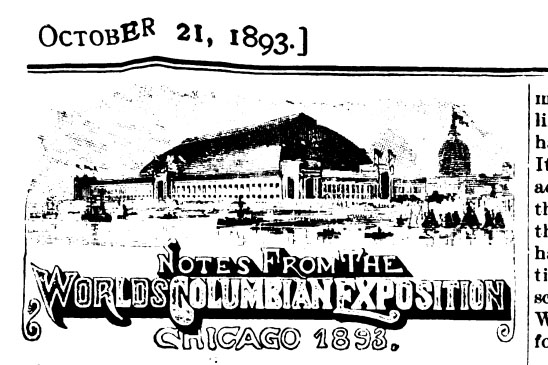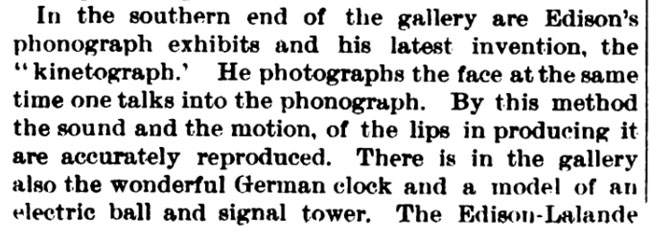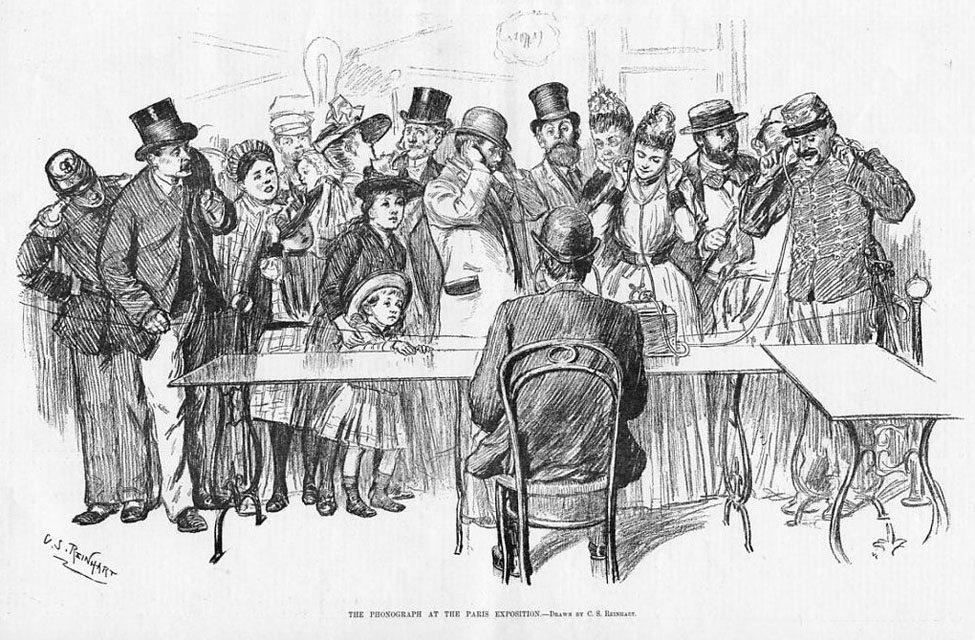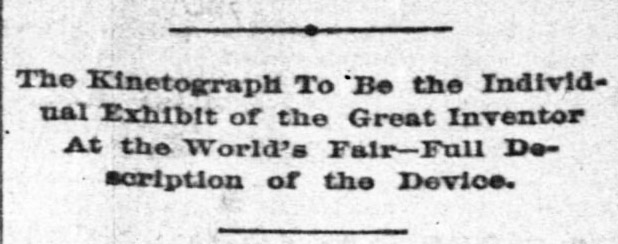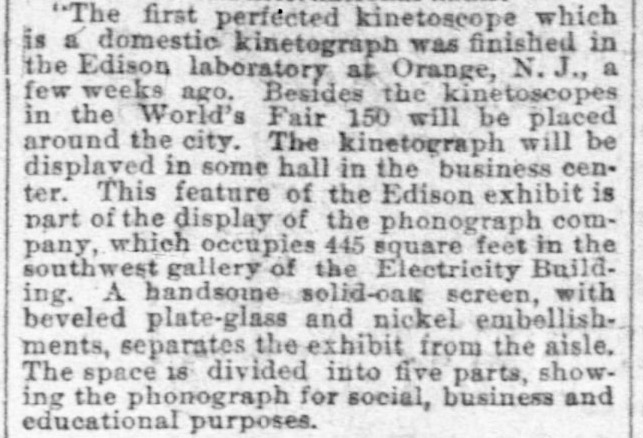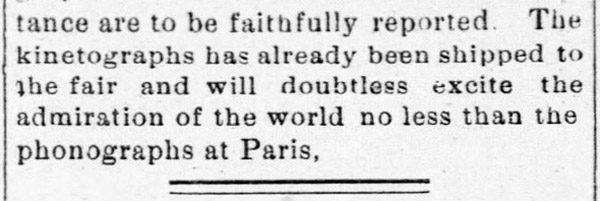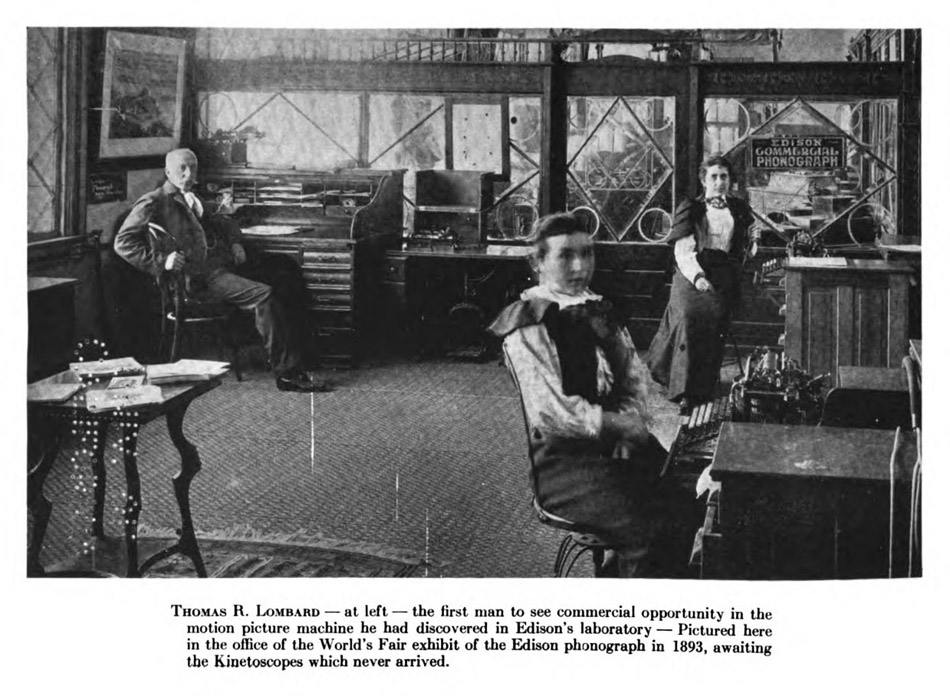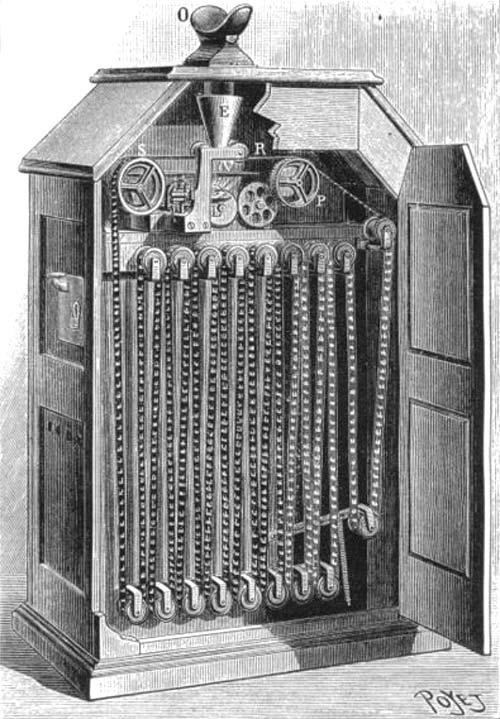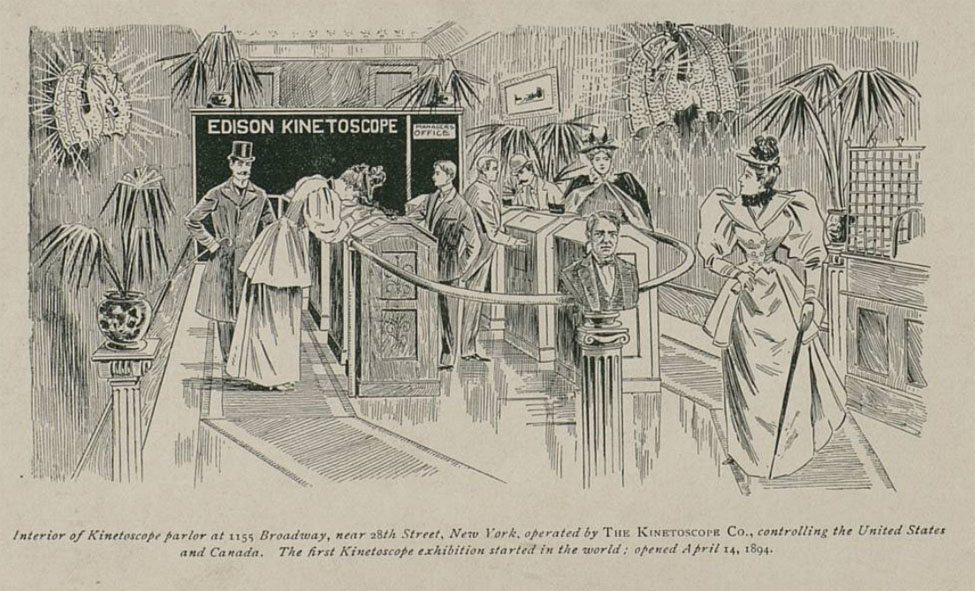The World's Columbian
Exposition of 1893 and the Kinetograph
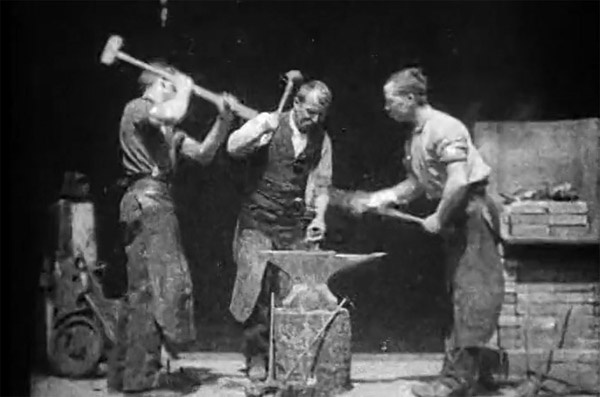
By Doug Boilesen,
2021
The Kinetograph
When the World's Columbian Exposition
published their Official
Guide of the World's Columbian Exhibition (before the fair
opened) it wrote "among the most unique exhibits is the new
kimetograph (sic) [kinetograph]."

Official Guide of
the World's Columbian Exhibition, 1893
On October 17, 1888 Edison had filed
a caveat with the Patents Office "describing his ideas for
a device which would "do for the eye what the phonograph does
for the ear" -- record and reproduce objects in motion. Edison
called the invention a "Kinetoscope," using the Greek words "kineto"
meaning "movement" and "scopos" meaning "to watch." A patent for
the Kinetograph (the camera) and the Kinetoscope (the viewer) was
filed on August 24, 1891. See kinetoscope
at Loc.gov.
The Prototype Kinetoscope
"On May 20, 1891, the first
public demonstration of the prototype Kinetoscope was given
at the laboratory for approximately 150 members of the National
Federation of Women's Clubs. The New York Sun described what
the club women saw in the "small pine box" they encountered: In
the top of the box was a hole perhaps an inch in diameter. As they
looked through the hole they saw the picture of a man. It was a
most marvelous picture. It bowed and smiled and waved its hands
and took off its hat with the most perfect naturalness and grace.
Every motion was perfect....(2).
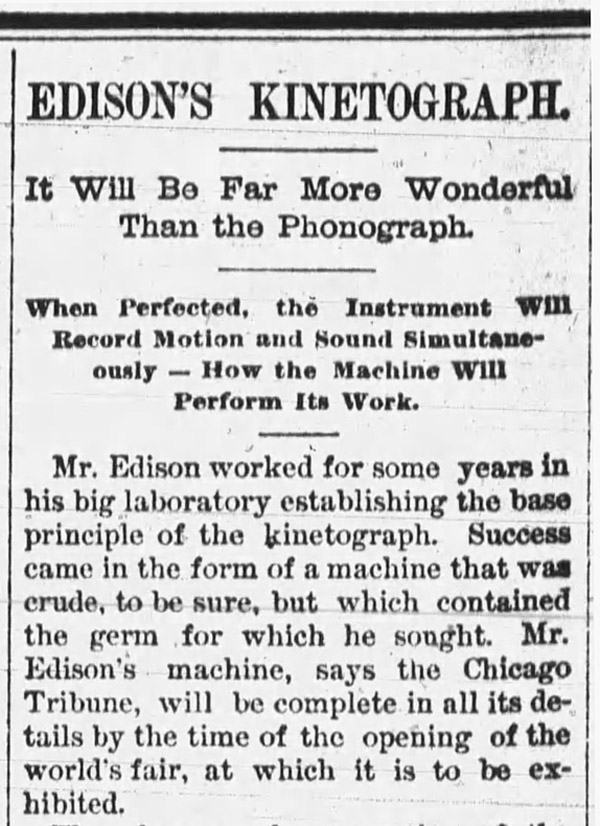
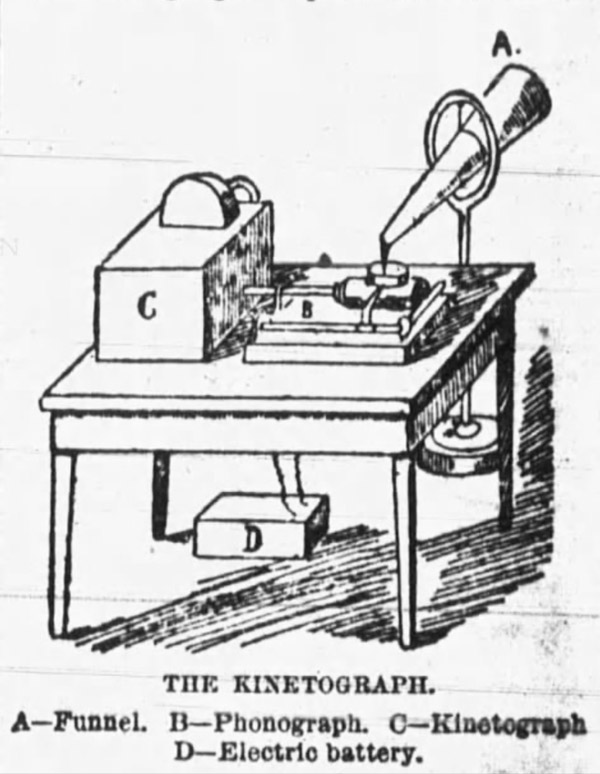
The
Aurora News-Register, Aurora, Nebraska July 18, 1891
"I think we'll have
the kinetograph through in time for the World's Fair," said
the inventor. "That's what I am working on it for."
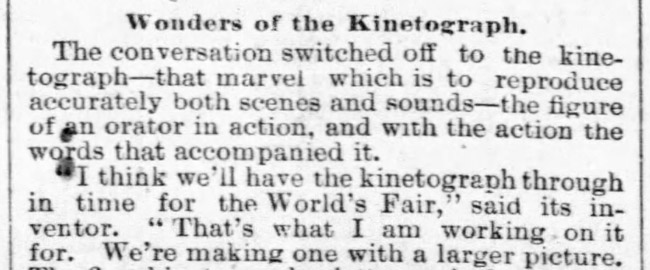
Chicago
Tribune, October 7, 1891
The Kinetograph's
First Public Demonstration
The kinetograph was first publicly
displayed on May 9, 1893 at the Department of Physics of the Brooklyn
Institute. Scientific American reported this event in their
May 20, 1893 edition saying that "the members were
enabled, through the courtesy of Mr. Edison, to examine the new
instrument known as the kinetograph." (1)
"The instrument
in its complete form consists of an optical lantern,
a mechanical device by which a moving image is projected
on the screen simultaneously with the production
by a phonograph of the words or song which accompany
the movements pictured. For example, the photograph
of a prima donna would be shown on the screen, with
the movements of the lips, the head, and the body,
together with the changes of facial expression,
while the phonograph would produce the song; but
to arrange this apparatus for exhibition for a single
evening was impracticable. Therefore, a small instrument
designed for individual observation, and which simply
shows the movements without the accompanying words,
was shown to the members and their friends who were
present."
"After projecting
upon the screen a few sections of the kinetograph
strip, the audience—which consisted of more than
400 scientific people— was allowed to pass by the
instrument, each person taking a view of the moving
picture, which averaged for each person about half
a minute. The picture represented a blacksmith and
two helpers forging a piece of iron...."
"The machine in
this case was not accompanied by the phonograph, but nevertheless
the exhibition was one of great interest. The kinetograph
in this form is designed as a "nickel in the slot" machine,
and a number of them have been made for use at the Columbian
Exhibition at Chicago."
The May 9 'kinetograph' was
defined in all reports as the device that included sound from
a phonograph that could synchronize the viewed movements and
lips of the moving photographs with sounds from the phonograph.
For that first public demonstration of that kinetograph, however,
the phonograph was not connected. At the end of the lecture
and demonstration the audience looked into the kinetoscope's
peep-hole viewer, each person watching a blacksmith scene
moving picture for less than 30 seconds.
Film
historian Charles Musser summarized the audience viewing
the kinetoscope film after George M. Hopkins finished his
lecture at the premier of Edison's new motion picture system,
the kinetoscope and kinetograph camera on May 9, 1893 as follows:
"When
the lecture concluded, at least two twenty-second films were
shown: BLACKSMITHING SCENE and HORSE SHOEING. Four hundred
people in attendance lined up in front of Edison's peep-hole
kinetoscope and one by one looked in the viewer and saw one
of these two films."
The May 20,1893 Scientific
American article concluded "The kinetograph in
this form is designed as a "nickel in the slot" machine, and
a number of them have been made for use at the Columbian Exhibition
at Chicago." This coin-operated kinetograph would
be known as the kinetoscope.

The Standard
Union, Brooklyn, May 10, 1893 reporting on the kinetograph's
first public demonstration
Going to
the Chicago and the World's Columbian Exhibition
The Ottawa Daily Citizen
reported in March 1893 that one hundred and fifty kinetographs
with moving pictures and sound will be at the World's Columbian
Exposition. The kinetograph will be an enclosed device with
a nickel in the slot mechanism that is coin activated. The
writer said that Edison "ought to make a fortune"
from his one hundred and fifty kinetographs at the fair.
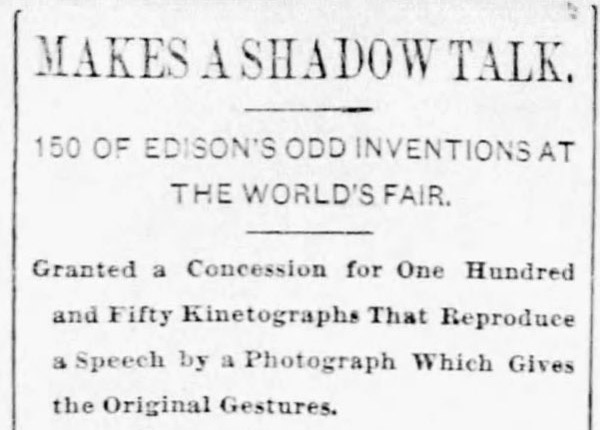
"going
to Chicago...as a penny-in-the-slot machine."
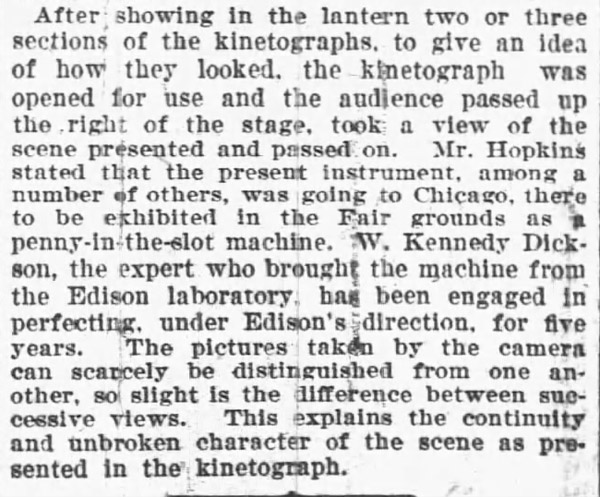
The Standard
Union, Brooklyn, May 10, 1893
Following the kinetograph's
first public display in Brooklyn The Standard Union said
that it "was going to Chicago, there to be exhibited in
the Fair grounds as a penny-in-the-slot machine."
"Edison
will lead the procession this summer at Chicago with "perhaps
greatest of his inventions, the kinetograph."
The Edison Kinetograph was an instrument
intended "to reproduce motion and sound simultaneously, being
a combination of a specially constructed camera and phonograph."
The kinetograph is a "combination photograph and phonograph"
explained the 1892 Historical
World's Columbian Exposition and Chicago Guide giving fair
visitors advance information on what they would be able to see.
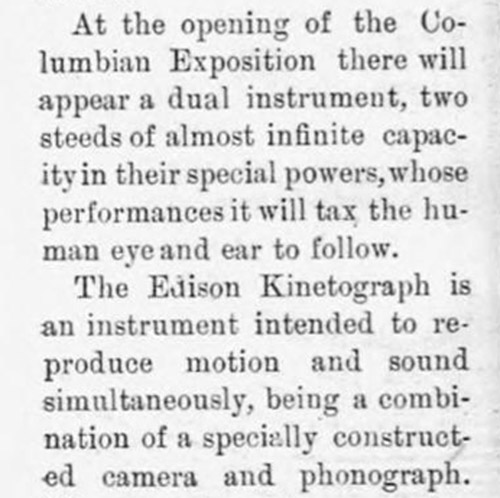
The Phonogram,
October, 1892, p. 217
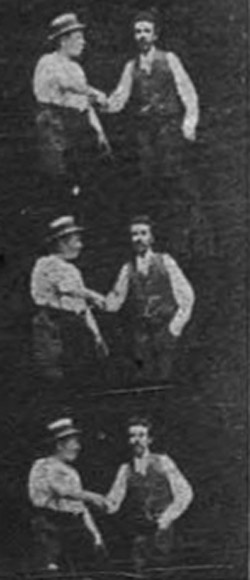
William K. Dickson and
William Heise, his associate and fellow filmmaker shake hands in
this kinetograph film,
The Phonogram, October 1892, p. 220.
The phonograph trade
magazine The Phonogram in their March-April 1893 issue noted
that "the famous Edison kinetograph" would be exhibited
in the Machinery Hall "under Class H, its proper classification."

The Phonogram,
March and April, 1893
"The Kinetograph
To Be the Individual Exhibit of the Great Inventor
At the World's Fair"
The differention between
the kinetograph and kinetoscope was clarified by Edison
in an April 1893 interview (The Indianapolis News,
April 27, 1893). "The kinetograph," he said,
"or, to put it more explicitly, the kinetoscope,
is a very simple device." Details followed but
it was all under a headline which emphasized that
"the Kinetograph was to be the Individual Exhibit
of the Great Inventory at the World's Fair..."
The
Indianapolis News,
April 27, 1893 p. 5
Additional information
was provided in an April 27, 1893 of the Indianapolis
News which noted that the "first perfected
kinetoscope which is a domestic kinetograph was finished
in the Edison laboratory at Orange, N.J., a few weeks
ago. Besides the kinetoscopes in the World's Fair
150 will be placed around the city. The kinetograph
will be displayed in some hall in the business center.
This feature of the Edison exhibits is part of the
display of the phonograph company in the southwest
gallery of the Electricity Building." This
would mean that the kinetograph exhibit was intended
to be part of the phonograph exhibit and that the
kinetoscopes as coin-operated devices would be in
other areas of the fair grounds and around the city.
The Indianapolis
News, April 27, 1893 p. 5
The
Alton Weekly Telegraph,
July 13, 1893 titled "The Kinetograph
and Kinetoscope" wrote that when Edison's nickel-in-the-slot
instrument is without the phonograph it is called
the kinetoscope but when a phonograph is
attached, "giving the sounds of the hammer
as well as the talking of the men" the instrument
is called the kinetograph." The "giving
the sounds of the hammer" was referring to
the Edison film "The Blacksmith Scene"
which was to have accompanied the film with phonograph
recorded sounds at the Brooklyn demonstration. That
first public display of the kinetograph on May 9
showed Edison's film "the blacksmith scene,"
however, it did not have sound as the phonograph
was not connected for that demonstration.
Was the Kinetograph at the World's
Fair in Chicago?
Over the years some film and other
historians have had different opinions about whether or not the
kinetograph was exhibited by Edison at the World's Columbian Exhibition
of 1893.
Scientific American,
October 21, 1893 reported that the kinetograph is "in the southern
end of the gallery" and that article has been cited as evidence
that there was at least one kinetograph as the fair.
Scientific American,
"Notes from the Worlds Columbian Exposition,"
October 21, 1893
The October 21, 1893
"Scientific American Notes" from the fair, however,
reads more like the description of a process than the actual watching
of moving pictures with sound.
"He photographs the face
at the same time one talks into the phonograph. By this method
the sound and motion, of the lips in producing it are accurately
reproduced."
Describing the process of making a
moving picture by photographing the face and recording the voice
at the same time on a phonograph was a common sentence included
in many newspapers about the kinetograph prior to the fair opening.
Likewise, newspapers often repeated
metaphors and similes to explain what the kinetograph does, e.g.,
the kinetograph "transmits scenes to the eye as well as sounds
to the ear;" and "it is to the eye what the phonograph
is to the ear."
This "process" description
by Scientific American on October 21, 1893, however, is insufficient
evidence that there was a kinetograph being exhibited at the fair.
Descriptions from the pre-fair newspaper articles and promotions
about the kinetograph going to Chicago are not evidence that anyone
actually saw the kinetograph at the fair. When the kinetograph was
first publicly displayed on May 9, 1893 at the Department of Physics
in Brooklyn before over 400 scientific people "the exhibition
was one of great interest" and there were details of what
was seen even though those moving pictures weren't accompanied by
the phonograph. "But even in this form it was startling in
its realism and beautiful in the perfection of its workings"
wrote the Standard
Union, May 10, 1893.
Therefore, where are any reports during
the fair about seeing the kinetograph and finding it "of great
interest?" Where is any sense of wonder, "the startling
realism," or the "perfection of its workings" portrayed
in this Scientific American article or any other newspaper
while the fair was open?
Newspaper articles that go beyond
the pre-fair explanations about the kinetograph and instead speak
of it as something being seen on exhibit at the fair are absent
during the entire time the World's Columbian Exposition was open.
The April 27, 1893 newspaper article
by Norton, Kansas's The Champion was written before the fair
was open and we know that it was mistaken in saying that the "kinetographs
had already been shipped to the fair."
What The Champion
did get right, however, was their anticipation that delivery of kinetographs
should "excite the admiration of the world no less than the phonographs
at Paris."
Visitors at the Paris Exposition
Listening to Edison's Phonograph, Harper's Weekly, illustration
by C. S. Reinhart, 1889
The Kinetograph was not at the World's
Fair
In her book Six Months at the World's
Fair by Mrs. Mark Stevens published in 1895 she says she tried
to cover as much of the fair as possible so that she could then accompany
the reader "over the ground from one p;oint of interest to another."
In visiting the phonographs in the Electricity
Building she went into some detail about how the sound of the music
would change when the speed changed. She remarked that since the Fair,
Edison has "made important improvements upon this instrument.
His kinetograph at the time of the Fair was not perfected, but we
presume that long ago it has been...This instrument was not at the
World's Fair, as he then was working upon an apparatus sufficiently
large to produce this very thing."
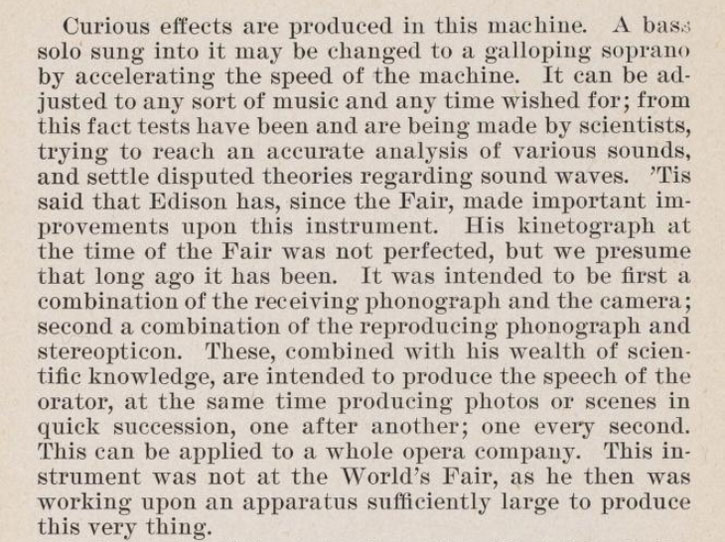
Six Months at the
World's Fair by Mrs. Mark Stevens, The Detroit Free Press Printing
Company, ©1895, p. 231.
;
Where was the sense of wonder and
admiration by the public at the fair for the kinetograph?
This lack of reporting reactions from
first-time viewers about seeing the kinetograph at the fair is counter
to the history of the public seeing such inventions for the first
time. The admiration the Parisian visitors gave to Edison's phonographs
in 1889 is an obvious example of enthusiasm and curiosity for a
new wonder. Even after the phonograph's coin-in-the-slot machines
had been introduced to the public in 1889 there would continue to
be many examples of the public listening to coin-operated phonographs
for the first time and finding it a delight and curious about what
was inside the box. Jokes were still being circulated in the first
decade of the twentieth century about listeners being confused by
the phonograph's realism and questioning the source of those sounds
("Where's the Band?"
humor).
When the first kinetoscope parlor
in New York City opened in April of 1894 six months after the fair
closed there was much public interest. Terry Ramsaye wrote the following
in his book "A Million and One Nights - A History of the
Motion Picture." (4)
"Holland Brothers's Kinetoscope
Parlor offering "the Wizard's latest invention" was
a Broadway sensation. Long cues of patrons stood waiting to look
into the peep hole machines and see the pictures that lived and
moved."
A first-hand report by Alfred O. Tate
of the Kinetoscope Parlor's opening night at 1155 Broadway provides
the best description of the enthusiasm of the crowd when Tate describes
how busy he was from the first ticket he sold until he locked the
door that night at one o'clock in the morning. "If we had wanted
to close the place at six o'clock it would have been necessary to
engage a squad of policemen."

Alfred O. Tate, "Edison's
Open Door - The Life Story of Thomas A. Edison A Great Individualist,"
(New York, E.P. Dutton & Co., 1938), 287.
There are no similiar
reports or evidence that anyone saw the kinetograph's moving pictures
or viewed a film through a kinetoscope at the World's Fair.
No kinetoscope, no synchronized
sound and no Edison films shown at the fair
Even if one kinetograph was delivered
and in "the southern end of the gallery" it would not
have been a functioning kinetograph connected to a phonograph providing
synchronized sound. The device that could display the "motion
of the lips" and the sound from those lips to be "accurately"
reproduced was still being developed and not available until 1895
when it came out as a kinetophone (the kinetophone being a combination
phonograph and kinetoscope). Dickson wrote in 1894 that "the
establishment of harmonious relations between kinetograph and phonograph
was a harrowing task... but "the experiments have borne their
legitimate fruit, and the most scrupulous nicety of adjustment has
been achieved, with the resultant effects of realistic life, audibly
and visually expressed." (8)
According to historian David Robinson"The
Kinetophone...made no attempt at synchronization. The viewer listened
through tubes to a phonograph concealed in the cabinet and performing
approximately appropriate music or other sound." Historian Douglas
Gomery concurs, "[Edison] did not try to synchronize sound and
image." (See Wikipedia's
kinetoscope and 'section "kinetophone"
for Robinson and Gomery quotes extracted 2-1-2022).
Terry Ramsaye, author of the 1926
"A Million and One Nights - A History of the Motion Picture"
did extensive research regarding the history of the kinetograph
and kinetoscope and interviewed many who were part of the film industry
from its beginning.
Prior to the opening of the fair there
were negotiations between Edison and Norman C. Raff, Thomas R. Lombard
and Frank R. Gammon which resulted in the rights of sale for the
Kinetoscope and the formation of the Kinetoscope Company. Ramsaye
describes how Raff, Lombard, and Gammon were "eager to introduce
their wonderous machine there. It was the prime opportunity to plant
the seed of a national and world distribution." (5)
Ramsaye then writes that "Edison
had supplies of neither machines nor film pictures for them. He
promised to rush them through. The opening of the Fair in Chicago
was delayed and it seemed possible that a battery of Kinetoscopes
could be ready."
There were efforts by Edison such
as the building of the world's first motion picture studio, the
Black Maria, to try to supply the Kinetoscope Company in Chicago
with films for the kinetoscopes (the "Black Maria" studio
at the Edison Laboratory was completed on February 1, 1893). Raff
and Lombard and the Kinetoscope Company waited for delivery of the
kinetoscopes and their films but Edison's lab had issues with key
personnel who were working on the kinetoscope. Further production
delays ultimately resulted in no kinetoscopes being sent to Chicago
while the fair was still open.
A Million and One
Nights, Ramsaye (5)
Edison did not deliver any Kinetoscopes
to Lombard and the Kinetoscope Company while the fair was open and
Ramsaye is definitive that no
Kinetoscopes were at the World's Columbian Exposition:

Another
explanation of events that contributed to not
even one Kinetoscope making it to Chicago comes
from film historian Charles Musser (7):
The Black
Maria was rarely used for production during
1893, as the refinement of Edison's motion
picture system and the manufacture of kinetoscopes
experienced delays. W. K. L. Dickson suffered
from nervous exhaustion and was absent from
the laboratory between early February and
late April 1893. Although this accounts for
some of the slowdown, the recession of 1893
may have further impeded this project, as
Edison devoted his hard-pressed finances and
time to iron ore milling. A new model kinetoscope
for films taken with the vertical-feed kinetograph
was probably not available until shortly before
the Brooklyn Institute demonstration in May.
A contract for the manufacture of twenty-five
machines based on this prototype was only
drawn in late June. Gordon Hendricks indicates
that it was given to an Edison employee who
had difficulty staying sober. As a result,
the machines were not completed until March
1894. Only the prototype was available for
exhibition at the Chicago exposition, and
this proved too valuable to send.
If the only kinetoscope
available for exhibition was the prototype that
was displayed at the Brooklyn Institute on May
9, 1893 and it "proved too valuable to
send" then the newspaper articles and pre-fair
publicity were wrong. The public would not get
their chance at the World's Columbian Exposition
of 1893 to see and express anything about the
kinetoscope.
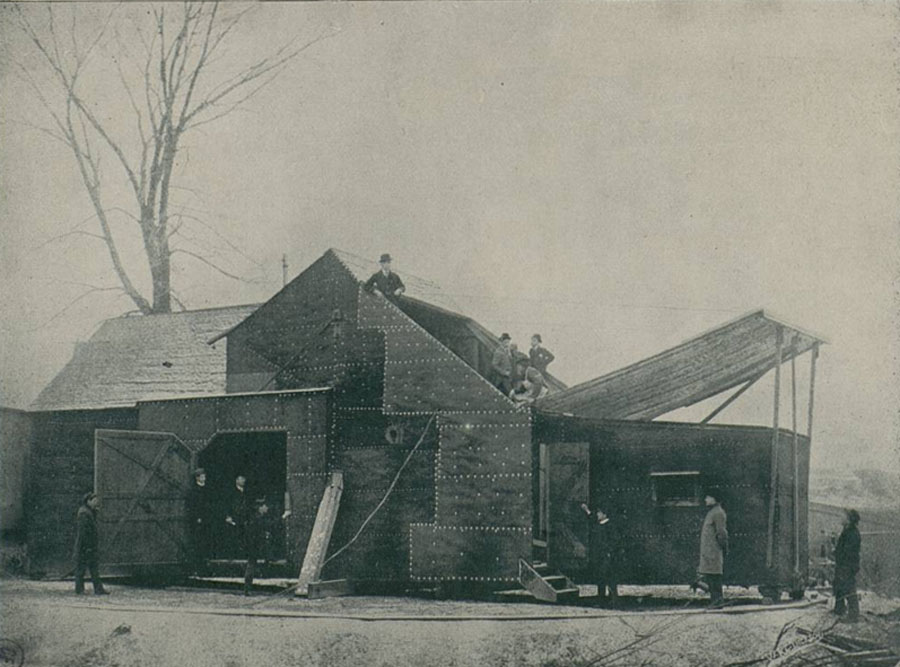
"The Black Maria" at Edison's
Lab which Dickson called "The Kinetographic Theatre" (Courtesy
Library of Congress) (8)
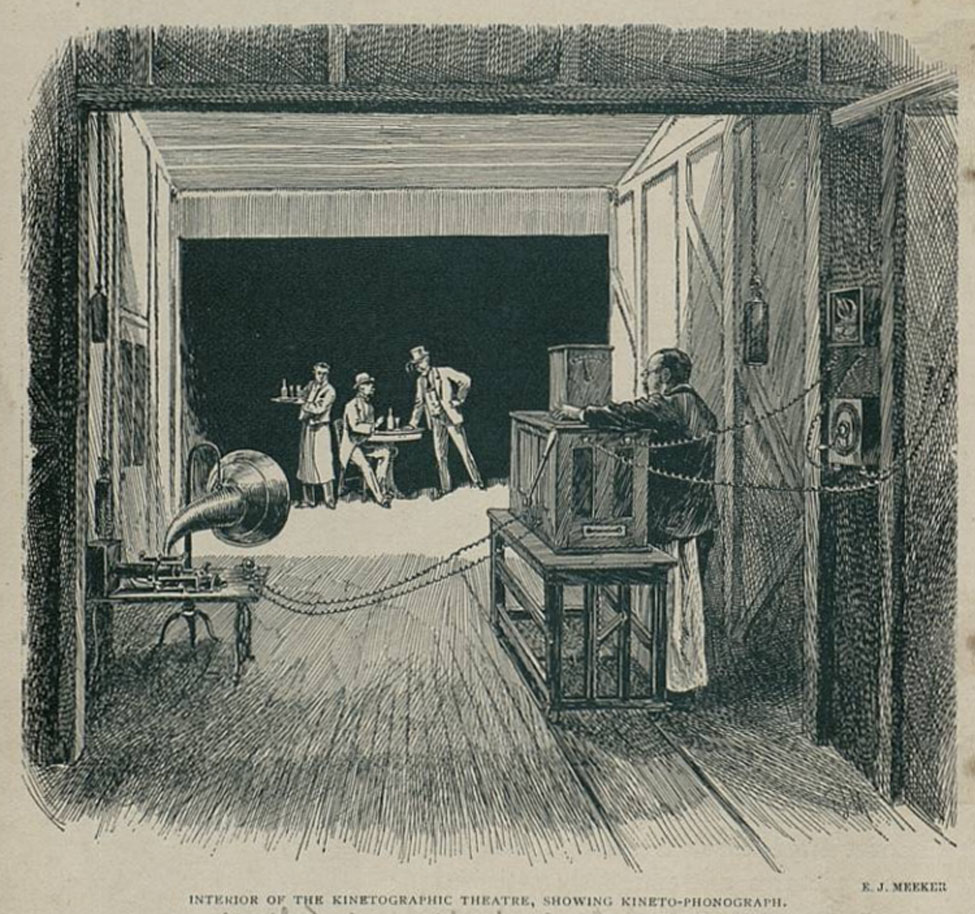
Kineto-Phonograph filming and recording
for moving picture with sound, 1894 (Courtesy Library of Congress)
(8)
The final and most compelling evidence
for answering the question of whether or not any kinetoscope was
at the fair comes from Edison's "Private
Secretary," Alfred O. Tate.
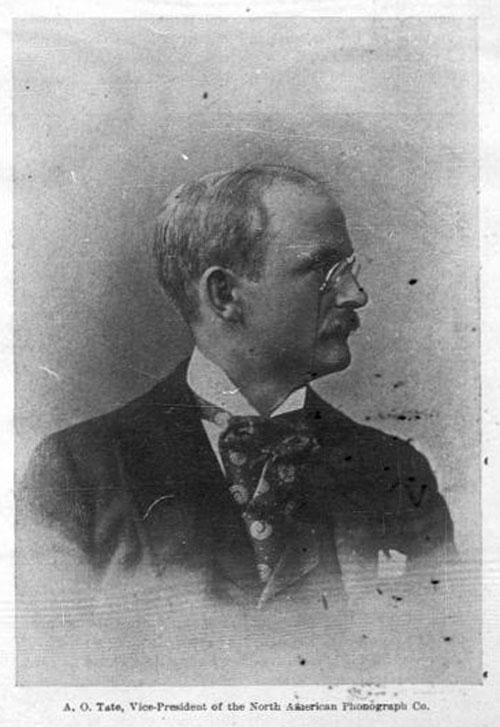
The Phonogram,
March - April, 1893
In his book "Edison's Open Door"
Tate describes his involvement in the original negotiation for kinetoscopes
at the fair and, with his front row seat in Edison's office, makes
it clear that the kinetoscopes were not completed on time and were
never delivered to the World's Columbian Exposition of 1893.
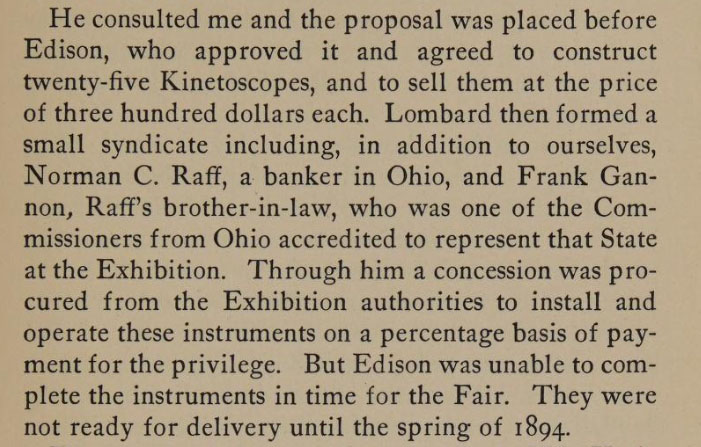
Alfred O. Tate, "Edison's
Open Door," Ibid. 285
Kinetoscope "finally
ready to be seen by the public..."
The experimenting
and development that were required "for the last six or
seven years" before Edison was ready to show his kinetoscope
to the public is mentioned in an April 1894 interview of Edison
and W. K. L. Dickson. Dickson tells the reporter that the kinetoscope
is finally ready to be seen by the public saying "although
their experiments are not yet carried to their conclusion, they
have reached a point where Mr. Edison is willing that the public
should see what they have done." (The
Philadelphia Inquirer, April 1, 1894)
The first kinetoscope shipped by
Edison was part of the delivery of ten machines to the New York
City kinetoscope parlor which went into operation on April 14,
1894 at 1155 Broadway, New York City. (9)
Details
of the Kinetoscope's opening night are described by Alfred
O. Tate in his book "Edison's Open Door."
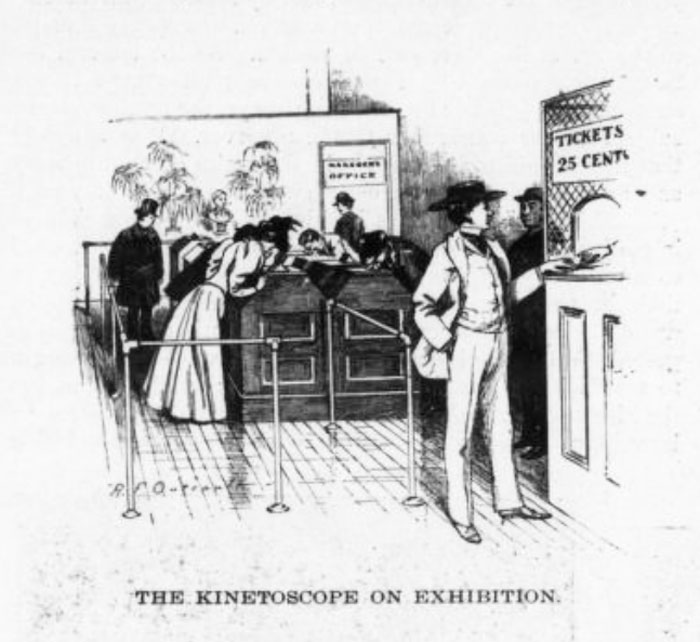
The Electrical World, June 16,
1894 by Richard F. Outcault (10)
Interior of first Kinetoscope Parlor,
1155 Broadway, New York,1894 (as seen in W.K.L. Dickson's History
of the Kinetograph Kinetoscope and Phono-Kinetograph) (8)
Gordon Hendricks in Origins of
the American Film noted that in this drawing of the parlor
"the Dicksons wanted to give the effect of elegance
in this parlour, and added palms, carpets, and waxed floors --
none of which may have been there: it is difficult to credit the
genteel patronage shown here. Note the incandescent dragons at
right and left and the bronzed bust of Edison in the foreground."
(11)
"The electric dragon with green
eyes" was "an Edison symbol supplied to parlor operators."
(12)
See
FACTOLA about the location of this first kinetoscope parlor.
Conclusion: The
kinetoscope was not at the World's Columbian Exposition of 1893.
There is no evidence that the kinetoscope
was at the World's Columbian Exposition of 1893.
Perhaps there was some type of display
in the southern gallery of the Electricity Building that may have
described what the kinetograph was and what it could do. But even
if a kinetograph exhibit was in that gallery there is no evidence
it was operational and no evidence that any device that "transmits
scenes to the eye as well as sounds to the ear" was at the World's
Columbian Exposition of 1893.
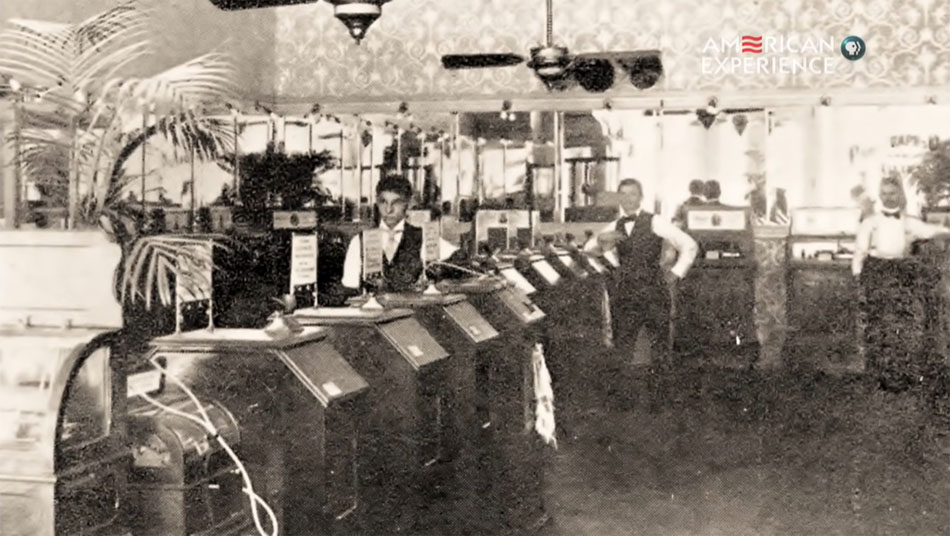
The first kinetoscope
parlor opened in April 1894 in New York City. Parlors in Chicago
and San Francisco quickly followed.
(Courtesy of American
Experience)
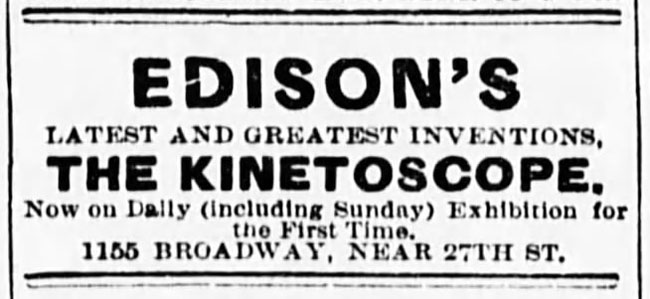
The World:Tuesday
Evening, New York, New York, May 29, 1894

Kinetoscope Parlor,
1895 lithograph (magazine)
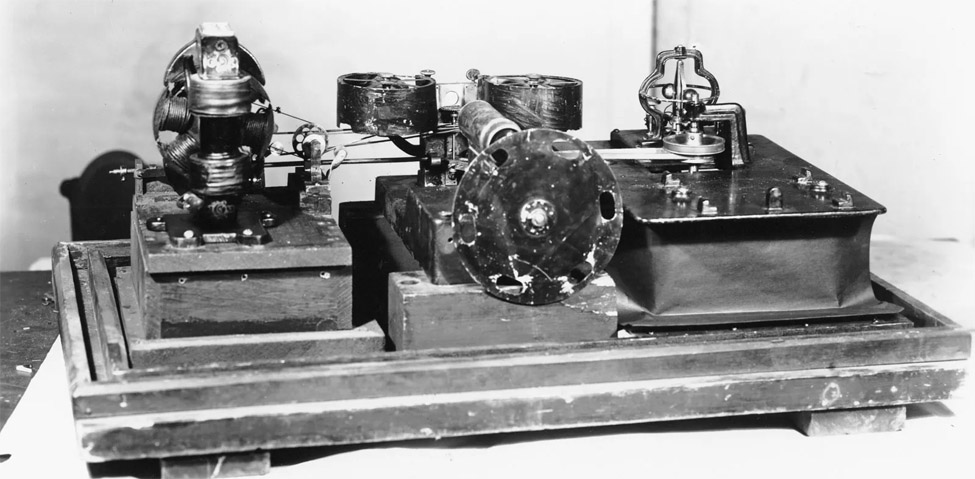
1889 Kinetograph
- The first camera to take motion pictures on a moving strip
of film.
(Courtesy U.S.
Department of the Interior, National Park Service, Edison National
Historic Site)

Reverse side of a
Kinetophone, showing a wax cylinder phonograph driven by a belt
(Courtesy Wikimedia
Commons and Podzo di Borgo).
1 - At the regular monthly meeting
of the Department of Physics of the Brooklyn Institute, May
9, the members were enabled, through the courtesy of Mr. Edison,
to examine the new instrument known as the kinetograph [sic
, i.e., kinetoscope]. - Document
No. 1 - Edison and the Kinetoscope 1888 - 1895, University of
California with original source Scientific
American, May 20,
1893, p. 310 - Musser,
Charles. Before the Nickelodeon: Edwin S. Porter and the Edison
Manufacturing Company. Berkeley: University of California Press,
c1991 1991. http://ark.cdlib.org/ark:/13030/ft3q2nb2gw/
2. Robertson, Patrick (2001).
Film Facts. New York: Billboard Books. ISBN 0-8230-7943-0, page
5. (Extracted from Wikipedia "Kinetoscope"
on 2-2-2022)
3. In the September 2, 1893,
issue of Electrical Review, Edison was described
as the Chicago World's Fair alone in the agricultural building
with "a pancake in one hand and a cracker spread with jelly
in the other."
4 - Terry Ramayse, A Million
and One Nights, Simon and Schuster, 1926 (Frontis) Ramayse,
Terry, A Million and One Nights - A History of the Motion Picture,
Simon and Schuster, 1926
5 - ibid "Raff, Lombard,
and Gammon were "eager to introduce their wonderous machine
there..." p. 81
6 - ibid (p.
85)
7 - "The
Black Maria was rarely used for production..."
Musser, Charles. Before the Nickelodeon: Edwin
S. Porter and the Edison Manufacturing Company.
Berkeley: University of California Press, c1991. pp.
38-39
7A - Thomas A. Edison
and his Kinetographic Motion Pictures, Musser,
Charles Rutgers University Press, 1995.
8 - The Kinetographic
Theatre at the Edison Lab - History
of the Kinetograph Kinetoscope and Phono-Kinetograph
by W. K. L. Dickson and Antonia Dickson, p. 53 ©1895
W.K.L. Dickson - University of Minnesota Press’s Library
of Open-Access Titles.
9 - See Edison and
the Kinetoscope: 1888-1895, Chapter
3 Exploitation of the Kinetoscope, p.45 - "Through
Tate, they had a long-standing order for the first
twenty-five kinetoscopes. As soon as these were completed,
ten machines were immediately installed at 1155 Broadway,
near Herald Square in New York City, where the kinetoscope
had its commercial debut on April 14th. A Chicago
kinetoscope parlor, using another ten machines, opened
in mid May..." Source: Musser,
Charles. Before the Nickelodeon: Edwin S. Porter and
the Edison Manufacturing Company. Berkeley: University
of California Press, c1991 1991. http://ark.cdlib.org/ark:/13030/ft3q2nb2gw/
10 - Origins of the
American film, Hendricks, Gordon, Arno Press,
New York, 1972 - Hendricks notes that "a possibly
somewhat more realistic view of the 1155 parlor may
be seen in The Electrical World of the June
16, 1894" rather than the April 15, 1894 opening
day interior illustrated in W.K.L. Dickson's History
of the Kinetograph Kinetoscope and Phono-Kinetograph.
11 - Hendricks Ibid.
Drawing number 36 - Comments from Hendricks about
Dicksons' History illustration of "Interior
of Kinetoscope parlor" which "opened April
14, 1894."
12 - Hendricks Ibid.
p. 59 - "the Edison symbol of an electric dragon
with green eyes, supplied to parlor operators, is
plain in the drawing of the 1155 parlor and elsewhere
in the literature."
13 - Robinson, David,
"From Peepshow to Palace The Birth of American
Film," Columbia University Press, New York,
1996. "Magic Lantern" vs. "Stereoptican"
nomenclature footnote, pp 3 - 4.
The
Kinetoscope - An American Experience PBS video
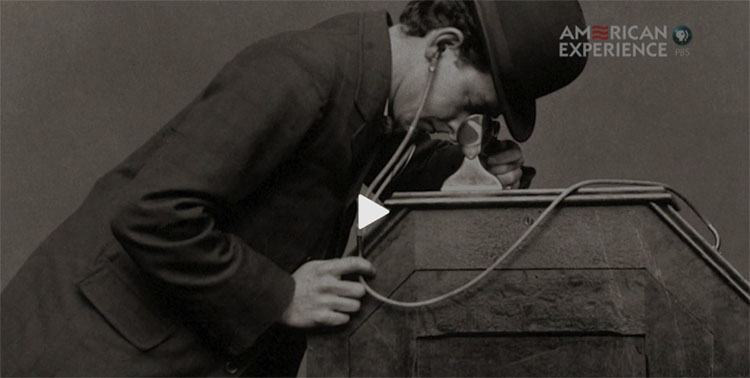
In the
1890s, Thomas Edison worked with his assistant and
part-time photographer, William Dickson to create
a motion picture camera. They created a series of
short films that could be viewed on a coin-operated,
peephole viewing cabinet called a kinetoscope. (3
minutes 32 seconds from 2015 PBS American Experience).
Wilkes-Barre
Times Leader The Evening News, May 28, 1891
- IT OUTEDISONS EDISON. The Latest Wonder from the
Wizard's Workshop.
Chicago
Tribune, May 13, 1891- Edison and the Big
Fair - "The Kinetograph and What He Claims for
It"
Chicago
Tribune, May 28, 1891 - "Light and Sound
United - Edison Outdoes Himself with the Kinetograph"
The
Pall Mall Gazette, London, May 29, 1891 - Mr. Edison's
Latest Invention. The Wonders of the Kinetograph.
Chicago
Tribune, October 7, 1891 - Wonders of the Kinetograph.
The
Phonogram, October 1892, The Kinetograph - A New Industry
Heralded
The
Historical World's Columbian Exposition and Chicago Guide,
Pacific Publishing Co., 1892
Ottawa
Daily Citizen, March 10, 1893 - Makes a Shadow Talk.
150 of Edison's Odd Inventions at the World's Fair
The
Chicago Tribune, March 23, 1893 - Concessions granted
for 50 Tachyscopes on Midway Plaisance
The
Indianapolis News,
April 27, 1893 p. 5
The
Champion, Norton, Kansas, April 27, 1893 -
Edison's World's Fair
Exhibit
The
Madison Chronicle, Madison, Nebraska April 27, 1893
- Edison's Latest Wonder. He Will Exhibit a Mechanical Retina
Which He Calls a Kinetograph.
The
Lindsborg's News Lindsborg, Kansas April 28, 1893 - Edison's
World's Fair Exhibit.
The
Standard Union, Brooklyn, May 10, 1893 - "Wizard
Edison - A Wonderful Instrument of His Exhibited at Brooklyn"
Scientific
American, May 20, 1893 - First Public Exhibition of Edison's
Kinetograph,
The
Evening World,
New York, May 28, 1891 - EXTRA "Edison's Newest
Wonder - The Kinetograph, A Surprising Invention for Reproducing
Motion"
The
Tennessean, Nashville, June 20, 1891 - "The
Kinetograph. Edison's Latest Invention - A Companion to the
Phonograph"
Vermont
Watchman and State Journal, Montpelier, VT, July 1,
1891 - "The Kinetograph."
Notes
from the Exposition by
J. C. Ruppenthal, Jr., The Russell Record, KS, July
13, 1893 - Edison Phonograph and Graphophone Coin-Ops and
Tachyscope
Aurora
News-Register, Aurora, NE July 18, 1891 - "Edison's
Kinetograph. It Will Be Far More Wonderful Than the Phonograph."
The
Alton Weekly Telegraph,
July 13, 1893 "The Kinetograph and Kinetoscope"
- "almost ready to be put upon the market but still at
Edison's Lab."
The
Brooklyn Daily Eagle,
July 16, 1893 - "SEE
THE FAIR FOR $100 - Story of a Brooklynite Who Took His Wife
to Chicago"
The
Waco News, The
Waco Evening News, August 19, 1893 - From Nan Manlove
Toby's column "IN SOCIETY - An Interesting Letter
From the White City."
St.
Louis Globe-Democrat, December 10, 1893- Edison's
Latest Inventions.
The
Pensacola News, August 23, 1893 - "Edison's Latest
- The Phono-Kinetograph Will Soon Be Brought Out"
Person
County Courier, Roxboro, NC, November 23, 1893 - Terms
Kinetoscope and Kinetograph
American
Society of Cinematographers - Overview of the Kinetoscope
and their restored Kinetoscope.
Muybridge's
Zoopraxographical Hall at the World's Columbian Exhibition
The
World's Columbian Exposition, Chicago, 1893. Trumbull
White and Wm. Igleheart, published by J. S. Ziegler &
Co., Chicago, IL, 1893. Edison's Exhibits and Kinetograph,
p. 326.
Edison
Barber Shop Film, December 1893
The
Philadelphia Inquirer, Philadelphia, PA, April 1,
1894 - "The Wonderful Kinetoscope - Edison's Latest Invention
Reproduces Nature's Movements with Wonderful Fidelity"
The
Inter Ocean by George M. Smith, Chicago, IL, April
8, 1894 p. 33 - "The Kinetoscope - A Sequel to the Kinetograph
Invention" (See Philadelphia Inquirer for April
1 report)
The
Larned Eagle-Optic,
April 20, 1894 - Wizard Edison's Latest - The Wonderful
Kinetoscopes and the Marvels It Accomplishes (Example of how
large and small newspapers repeated this story)
Edison's
personal testimonial to Ramsaye's research and "unrelenting
effort at exact fact."
Fairground
Fiction in Newspapers - Letters to the editor and visitor
accounts about the 1893 World's Fairs and printed in newspapers.

|

